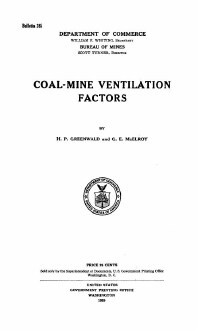Mining Publication: Coal-Mine Ventilation Factors
Original creation date: January 1929
Authors: HP Greenwald, GE McElroy
NIOSHTIC2 Number: 20036790
U.S. Department of Commerce, Bureau of Mines. Bulletin 285, 1929 Jan; :1-106
Ventilation has been a primary problem in coal mining since mines were first worked under sufficient cover to encounter inflammable or other noxious gases. Quantitative requirements conforming to established safety standards are well known, so that the major problem that confronts the mine operator is: How can the necessary volumes of air be taken from the atmosphere outside the mine and efficiently distributed to the working faces? The problem of coursing mine air divides naturally into two parts; the first concerns the fan and its prime mover, and the second concerns the mine through which the fan must force the air current. The design and efficiency of fans have received much attention from manufacturers and others, but the resistances encountered by moving air underground and means of reducing the resistances have not received an equal amount of investigation. This is natural, because investigations of value could be made only in actual mine workings and then only with the aid of delicate and expensive measuring instruments. Furthermore, few operating mines could well consent to the interruptions that extended work of this kind would cause. In coal-mine ventilation problems the works of Atkinson and Murgue have been the standard guide for many years. Later compilations have been made, such as that of Fitch. However, though most of the experiments of these authorities were carefully conducted, their results are suspected of containing large errors. It was thought that such errors could be eliminated in new determinations by the use of more sensitive instruments and by the observance of certain details of technique essential to the correct measurement of air flow and the pressure differences causing it. It was also thought desirable to extend available data to cover conditions found in modern coal mines. The Bureau of Mines is fortunate in owning an experimental mine. This mine has been developed in the Pittsburgh coal bed at Bruceton, near Pittsburgh, Pa., and allowed this investigation to be conducted in actual mine workings. The test work which forms the basis of the present report was started in January, 1922; it was not completed until November, 1923, however, partly because of the necessity of developing methods and instruments, but mainly because of delays and interruptions occasioned by other test work. Concurrently, similar investigation of metal-mine ventilation factors was conducted by the Bureau in the metal mines of Butte, Mont., and a report of this work has been published. Less extensive investigations of a similar precise nature have been conducted by the Bureau in an Indiana coal mine and by the University of Illinois Experiment Station in Illinois coal mines.

NIOSHTIC2 Number: 20036790
U.S. Department of Commerce, Bureau of Mines. Bulletin 285, 1929 Jan; :1-106
- A Centennial of Mine Explosion Prevention Research
- CO and CO2 Emissions from Spontaneous Heating of Coal Under Different Ventilation Rates
- Development and Application of Reservoir Models and Artificial Neural Networks for Optimizing Ventilation Air Requirements in Development Mining of Coal Seams
- The Effect of Ventilation on Spontaneous Heating of Coal
- The Effects of Roof and Floor Interface Slip on Coal Pillar Behavior
- Effects of Ventilation and Gob Characteristics on Spontaneous Heating in Longwall Gob Areas
- Field Study of Longwall Coal Mine Ventilation and Bleeder Performance
- Occurrence and Remediation of Coal Mine Bumps: A Historical Review
- Removing Methane (Degasification) from the Pittsburgh Coalbed in Northern West Virginia
- Reservoir Modeling-Based Prediction and Optimization of Ventilation Requirements During Development Mining in Underground Coal Mines